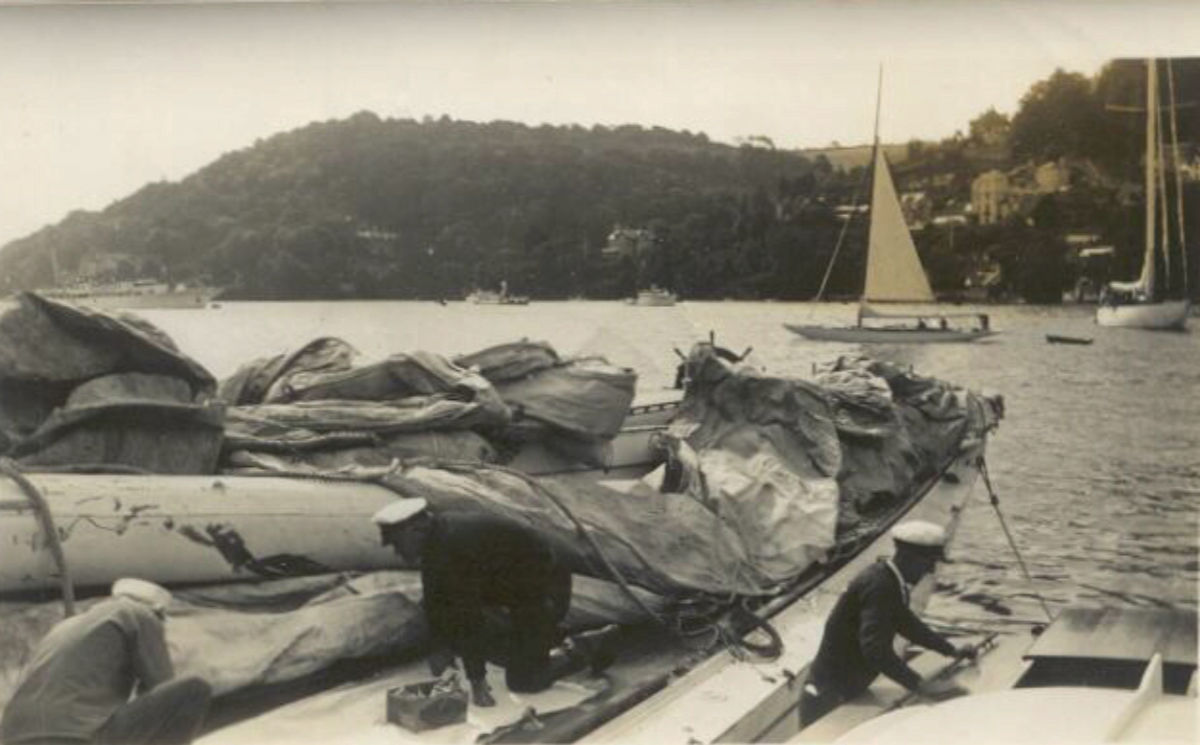What was it like to be a crew member on a boat like the “Yankee” – and how did the dramatic dismasting at Dartmouth unfold for those on board? The diaries of Ole P. Dalland give us a unique insight.
From his homestead at Øvra Dalland, Ole P. Dalland (1904–1985) like many others from Tysnes had travelled to America to try his luck “over there”. He started yacht sailing in 1928 and was a crew member on the “Yankee” in the seasons 1935 and 1936, together with many others from Tysnes. The diaries he kept have been taken care of by his descendants and are valuable sources of insight into this special life.


Saturday 31 August 1935 had looked promising from the start. The day before, the competition was cancelled due to rough conditions, but today the race is on, we can read in the diary:
This morning when we came on deck it was raining and blowing quite a bit like yesterday, but after a while it cleared up, so we polished the brass and got the spars and sails ready as usual. After a while they hoisted the flags on the committee boat, announcing that there will be sailing today. So, we weighed anchor and roped outside where there was a strong wind blowing and more like yesterday.
Hubris?
A little further down we can read what might explain the drama that was about to unfold:
At 11 o’clock we crossed the line with the best start we had all summer. We had only broken out a single foresail at the time, but since we couldn’t get away from the other boats, we broke out a double-clewed jib as well and now had a lead over the others.
The J-boats were rigged with two foresails. Two of the other boats had hoisted a storm jib, i.e. a smaller sail, as the second foresail, while “Yankee” had a regular one. Together with a reefed mainsail this probably caused too much and unbalanced pressure on the mast. Was it overconfidence in the pursuit of victory in the last race of the season? Because soon it happens:
It had been going well so far, and we were in the lead. But just 20 meters ahead of the first rounding buoy we heard a crash and the next thing we knew, the mast, boom and sails with all the rigging were scattered across the deck and the rest in the sea, and no one knew anything until it was all over.
Could have been worse
The accident is dramatic and soon the other boats come to the rescue. No one wants to sail on, and the race is cancelled. It looks bad, but it could have been worse. Almost as if by a miracle no one is missing or seriously injured:
[…] two men [were] thrown overboard, but fortunately we get them back up immediately, but several were about to go overboard. There was nothing that gave way on the rigging. It was the mast that could not withstand all the pressure and collapsed one foot above deck and another place 40 feet above deck. But the great miracle was that none of the 27 men, who were lying carefree around on deck, were hurt. Had it happened 5-6 minutes earlier, when all the men were down on the leeward side tightening the spars, there would have been 8-10 fewer men on board. But such is fate. So the first thing we did was to see if all the men were accounted for.
After a while a fishing boat arrives to tow the casualty to shore. It is an arduous operation. It takes over two hours, and on the way in the mast scrapes against the bottom time and time again. The owner of the “Shamrock” has a pleasure yacht nearby and tries to lift the mast up into the davits (devices for attaching lifeboats and other small boats to larger vessels). This was work to no avail, writes Ole P. Dalland:

We had to give it up and tow it up to a shipyard to get some cranes on it and the mast was so stuck in the seabed in some places that we had to have three tugboats on to get it up there.
It was hard work to clean up after the dismasting, and the despondency after the accident probably didn’t make it any easier.
The whole thing, sails and rigging, was appallingly full of filth and dirt, and the top of the mast had broken off on the way in. When everything was loose, it was time to get the sails on board and all the rigging on top of it so it’s lying around here now in a horrible mess.
The day after
The following day, Sunday 1 September, must have felt more like a blue Monday:
Sunday is not something to enjoy for us today because the first thing we had to do was clean up that mess with the rigging and sails and the whole crew spent all morning on it.
On Sunday afternoon they weighed anchor and were towed to a buoy. There a tugboat would pick them up early the next morning for transport to Gosport, a little further east on the coast. Here the “Yankee” would lie over the winter for repair and preparation for the 1936 season, when Ole P. Dalland would also be on the crew. And he continued to write a diary.
Here at jaattlaget.com we plan to gradually publish more of his stories about life on the “Yankee”.
TOP PHOTO: “When everything was loose, it was time to get the sails on board and all the rigging on top of it so it’s lying around here now in a horrible mess … so the expensive yacht Yankee doesn’t look like a yacht anymore, but a total wreck.” Photo: Ole P. Dalland


Leave a Reply